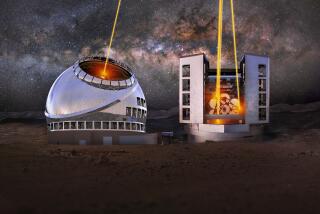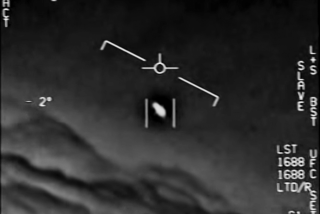Heaven on earth
Monmouth, Ore. — JOHN DOBSON fumes while shuffling between half a dozen homemade telescopes arrayed across a yard like cannons.
It’s hot here in the Willamette Valley, and Dobson has been teaching pupils the intricacies of telescope building for three weeks, and he’s losing patience. The heat is baking the old man’s shirtless skin red, and his white ponytail glistens.
He roams among his students, some in their 30s and others who are seniors, as they polish reflecting mirrors by hand. Dobson fixes his glare on one struggling scope maker, who can’t figure out why his mirror is out of focus, then blisters him like a drill sergeant.
“Why would the light from the center be brighter when it’s out of focus!” Dobson roars.
Befuddled, the student freezes, stares at his telescope and suggests the center of the mirror isn’t hollowed out enough in the middle.
“So, the center is too high!” Dobson bellows. “Is that so complicated?”
He tells the pupil to hand polish the mirror more. Dobson knows his bellowing unnerves some students, but he’ll turn 90 next month and he says he’s too old to change. “I just get impatient,” he shrugs.
And no one protests. They don’t even bad-mouth him, so great is their reverence for the man. He has devoted his life to wrestling astronomy away from the pointy-headed astrophysicists in universities and has brought stargazing down to common, Earth-bound people.
A champion of inexpensive equipment, and a popularizer of space, Dobson was instrumental in raising the status of amateur astronomy to near-professional level. “He’s your basic living legend,” says Jacque Greenfield, an office manager from nearby Salem who came to build a telescope.
To his admirers, Dobson’s a hero, and to his detractors he’s a crackpot. And for those who have gathered in Monmouth -- his stargazing disciples -- it is an honor to sit at the feet of the master (never mind that the three-week class costs $120, plus about $350 for materials).
But opinions matter little to Dobson. He does what he does, knowing his place in the annals of astronomy is set. Nearly 50 years ago, he was thrown out of a monastery for sneaking off at night to make cheap telescopes out of scrap. He lugged the devices around San Francisco streets to offer people a glimpse at the far-flung wonders of the cosmos.
Now he spends 10 months a year on the road, living with fans, sharing his well-honed telescope-making techniques and giving lectures on the nature of the universe. He accepts nearly every invitation to “star parties,” the semisocial, all-night gatherings of amateurs. His followers bring their telescopes hoping he will autograph them. Still, Dobson makes little money on these gigs; he says he hasn’t paid income tax since 1944. It’s more calling than profession.
The documentary film, “A Sidewalk Astronomer,” which was released in July, follows Dobson from San Francisco, where he co-founded the San Francisco Sidewalk Astronomers, to campuses, star parties and to Stellafane, an annual telescope makers’ convention in Vermont. The sidewalk astronomy club now boasts a worldwide membership.
Back on the lawn, the students sit on wooden planks. Making telescopes is key to Dobson’s teaching technique; he wants his students to understand how to use the devices as tools to penetrate space. The students polish their mirrors with water and powdery cerium oxide. They press the mixture between the glass and a pitch lap -- a round waffle-shaped tool -- and rub in a circular motion to get the parabola-shaped depression just right. The margin of error is thin: Get it wrong by even a minuscule amount -- just 1/1,000th of the thickness of Saran Wrap is all it takes -- and the mirror is ruined.
The workload weighs on Dobson’s thin, sagging frame as the sun begins to dip over Oregon’s Coast Range. None of the telescopes have yet to win his approval, so he ducks inside the house for a dinner of salad and potato soup.
Calmer, he talks about his life, his future and his legacy. He jokes that he is famous for being too dumb to build an equatorial mount, the expensive and complicated telescope base used by most astronomers before his Dobsonian mount came along.
But he hopes his legacy goes beyond his telescope design. He wants to be known for advancing his theory for the creation of the cosmos, a model he calls “bang free” because it runs counter to the widely accepted big-bang model. “I prefer to be known as a cosmologist because I’m not interested in just the stars,” he says. “I’m interested in the whole ball of wax.”
*
Jupiter’s the draw
ON a warm, clear night in the Roth’s supermarket parking lot in Independence, Ore., Dobson stands under a street lamp and calls to shoppers like a circus barker. His scratchy voice carries over the commotion of cars and skateboarders. “We are looking at Jupiter,” he says. “Come see Jupiter.”
Next to him is a weathered 10-inch-diameter telescope -- a classic Dobsonian with a plywood mount and a cardboard tube, normally used to form concrete columns. A washbasin drainpipe holds the eyepiece and the secondary mirror is propped up with three pieces of cedar shingles.
Dobson makes it a point to take a telescope to a public place as often as the weather allows. In the parking lot, Dobson seems more at ease. He saunters around as he talks and swings a plastic grocery bag stuffed with leaflets announcing his upcoming cosmology lecture.
There are no telescopes to appraise. No students to berate. Just a starry sky, a telescope and a crowd to win over.
But the shoppers are leery of the old man. Several shoppers avoid eye contact and scurry past. A woman pushing a stroller comes near and Dobson says, “Put your kid in park and come see Jupiter.” She moves on.
A young couple approach Dobson and his contraption.
“That’s Jupiter?” the young man asks, gazing through the eyepiece.
“That’s cool,” the girl says, after taking a peek.
“It’s not cool,” says Dobson. “It’s frigid.” (The average temperature on Jupiter is about minus 166 degrees Fahrenheit.)
The supermarket closes and Jupiter sets behind a street lamp.
It was Jupiter’s colorful bands that first piqued Dobson’s interest in the heavens.
As a kid, he peered through his father’s small, refracting telescope and then sketched Jupiter’s swirling bands on blue sheets of paper.
Dobson was born in China, where his grandfather founded Peking University and his father taught zoology. His mother was a musician. The family fled to San Francisco in 1927 to escape turmoil as Chiang Kai-shek sought to unify China against the country’s warlords.
Dobson studied chemistry at UC Berkeley and worked briefly as a chemist at Caltech and the former Berkeley Radiation Laboratory.
An atheist since high school, Dobson began to rethink his ideas about science and God after hearing a lecture by Swami Ashokananda of the Vedanta Society, part of the Rama Krishna order. In 1944, he entered the monastery in San Francisco.
At the urging of a fellow monk, Dobson built a telescope by hand. He scrounged boat salvage yards, hardware stores and rubber company trash bins for parts.
But at the time, the most popular bases for telescopes were tripods that could be assembled with plumbing pipes, counterweights and bearings. They could hold only small telescopes, 4 to 6 inches in diameter.
Dobson came up with a simpler, cheaper base made of plywood. The Dobsonian mount consists of two wooden boxes, one stacked atop the other. The bottom box swivels from side to side while the top box holds the telescope tube and pivots up and down. A sharp push moves the tube in any direction. Not only is his design easier to build, but it holds bigger, more powerful telescopes.
He made his first telescope out of a 12-inch-diameter glass porthole, and turned it on a third-quarter moon. “I thought, ‘My God, everybody has to get to see this,’ ” he says.
Soon Dobson regularly sneaked out of the monastery, pushing the telescope around the streets of San Francisco, intent on showing the world the sights that so enthralled him. He also taught people to build their own telescopes. But the monastery leaders threw the AWOL monk out in 1958 and tossed his telescope in the bay.
*
An avid audience
ON a Friday evening in a classroom at Western Oregon University in Monmouth, Dobson sits on a chemistry lab table, putting on a show for about 40 astronomy buffs who sit riveted as he explains his theory of the cosmos. But this is no dull science lecture. Dobson is animated, bellowing at times to get his points across. He swings his feet and tells jokes.
Someone asks if Dobson believes in God.
“Yes, but I don’t have her number,” Dobson quips.
“You seem to be a bit of a maverick,” another man tells him.
“No, you can take out the ‘a bit’ part,” he says.
Dobson’s ideas don’t always get such an accepting reception. Physicians and cosmologists dismiss his theory, calling it misguided and unsubstantiated. But they credit Dobson’s other contributions to astronomy.
Dobson’s telescope mount, they say, allows amateurs to delve into the regions of space that 10 years ago were the exclusive purview of professionals.
“John Dobson is worth his weight in gold,” Fred Watson, astronomer-in-charge of the Anglo-Australian Observatory at Coonabarabran in New South Wales says via e-mail. “Because of his development of a cheap, easy-to-make type of amateur telescope, his name has become part of the everyday currency of telescope making.”
After his lecture, Dobson walks through the parking lot. It is after 9 p.m. and a dozen telescopes, mostly handmade Dobsonians, are pointed at the dark Oregon sky, including a few made by the students he berated the day before. Dobson strolls past; he rarely looks through the eyepieces. He has seen all they have to show. “It’s virtually impossible to entertain me at a star party,” he says.
Around him, the stargazers are calling out the names of the sights coming into focus: Jupiter ... a double star ... a globular cluster and more.
But Dobson spends most of the night encircled by astronomy buffs, spellbound by his humor, anecdotes and theories on such topics as child rearing and religion. Under the arc of the Milky Way, Dobson is in his element. He is a star, drawing people like orbiting planets.
The gathering draws to a close, Jupiter begins to set on the horizon and a burly telescope-making student approaches to shake Dobson’s hand and thank him for provoking him to think about his place in the cosmos.
“Well, I do get people to worry about things,” the old astronomer says as he turns and leaves.
*
Hugo Martin can be reached at hugo.martinlatimes.com.
More to Read
Sign up for Essential California
The most important California stories and recommendations in your inbox every morning.
You may occasionally receive promotional content from the Los Angeles Times.











